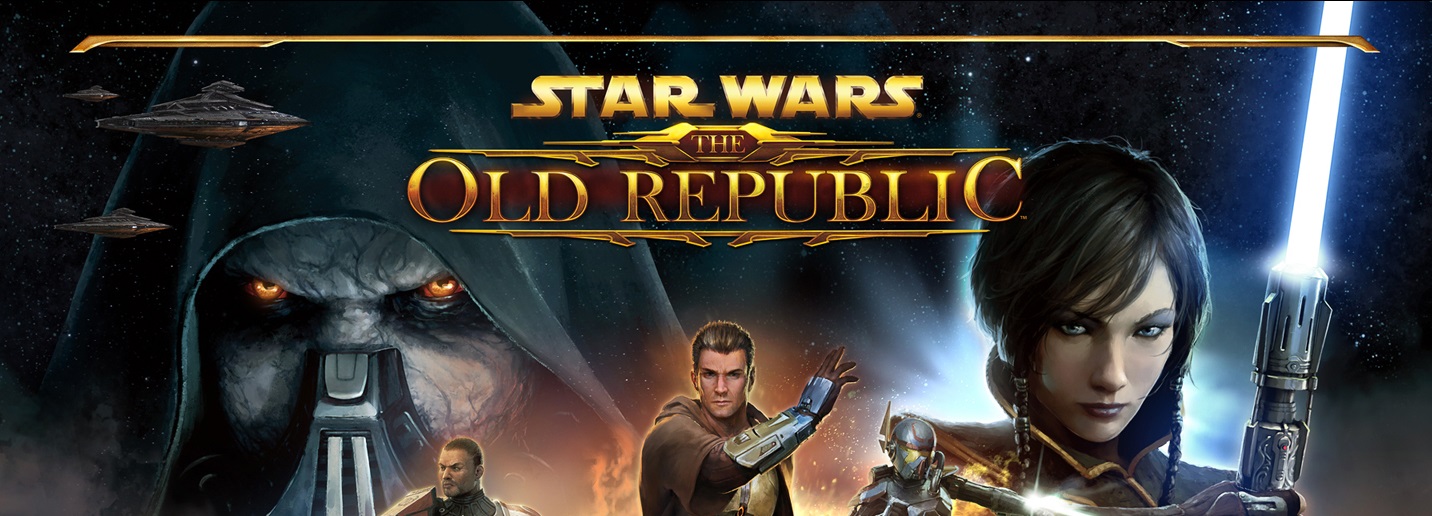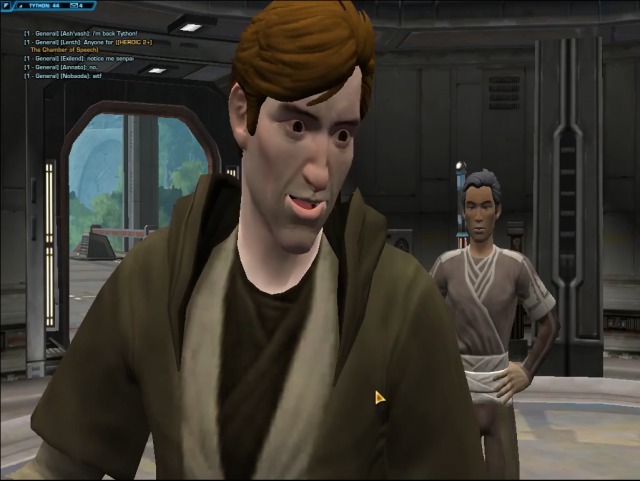It didn’t have to be this way
When you look back at a game like Star Wars: The Old Republic, the first question that comes to my mind is “What were the developers *trying* to build?” There are often questions about whether the game significantly differed from the original vision, and if so, how.
Amusingly, the original vision was fairly similar to what the final product was – essentially World of Warcraft — in Space, but with lightsabers. And you know what the worst part is? They fail to deliver on the lightsabers.
This was no accident – it was a deliberate choice by the design team not to innovate, to “not recreate the genre so they could aim at their core first,” to summarize the words of Richard Vogel, the game’s Executive Producer. In plain english, this meant to stick with World of Warcraft’s system of mechanics and gameplay in order to appeal to fans of the classic MMORPG.
Where they chose to innovate, if innovate is indeed the proper word, was with story, based on Bioware’s “tradition of excellence in digital storytelling.”
The claim was that this still represented more innovation than generally seen in other popular genres like First Person Shooters – but this is missing the point, and honestly, fairly insulting to first person shooters like Bioshock Infinite, Halo, Half-Life, and others which are built on a legacy of gameplay innovations. Even something like Call of Duty involves hours of painstaking research into futuristic weapons, tactics, etc.
The painful truth is, no matter how hard we searched, we couldn’t find evidence of any grander vision than this throughout the development process. The fact that we couldn’t really…is disappointing. Especially on a project that should have been well documented, well publicized, and have major community elements defending it – if not out of the genuine enthusiasm, then at least communities and shills bought and paid for with part of the $400 million they spent.
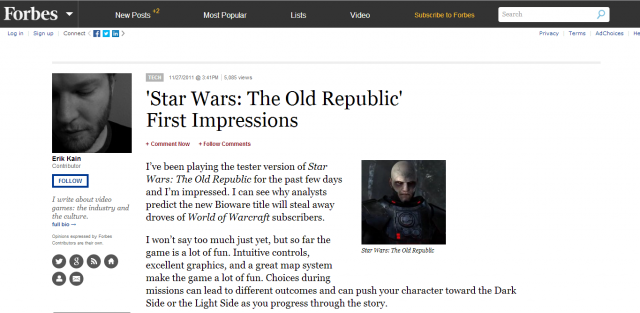
Or perhaps they spent too much on media attention and not enough investing in a community, given that I first heard about this game in Forbes. Think about that. Who the hell reads about a game in Forbes? Worse, the Forbes article was in regards to its monetary potential, not even about the gameplay or anything that would make me want to play it — the article came from a perspective that knew little about games.
Frankly, I was left with the impression that this was yet another attempt at making a “WOW-Killer” which would inevitably fail in about 6 months, at best. And to no one’s surprise, within 6 months, the number of subscriptions had plummeted so far that the decision was made to switch to a Free to Play model, ending their rule as the “second largest subscription based MMO in the Western world”, the humorously qualified phrase James Ohlen, the Game Director of TOR used to describe the game in early 2013.
Whatever they wanted, it fell short.
The Shortcomings
The game falls short in many ways described in our first impressions post last week, but even beyond that, the Free-to-Play mechanic makes an already tedious game even more of a slog.
Now, one thing’s worth admitting, the game is hands down at its strongest when its putting you on the “main quest” of your class. In some cases, the class story is actually decently designed, giving you something to care about – something to feel invested in – as opposed to the ubiquitous throwaway sidequests to collect 5 Mangka cat teeth or what have you – which all, by the way, come with long cutscenes and force you to make conversation choices that do absolutely nothing.
The main quest – for some classes – is when you actually feel inspired to give one whit of emotion regarding how things proceed. Unfortunately, the rest of the time, one’s emotional state tends to default to frustration, rage, or a sense of detachment as one wonders why one isn’t playing a better game.
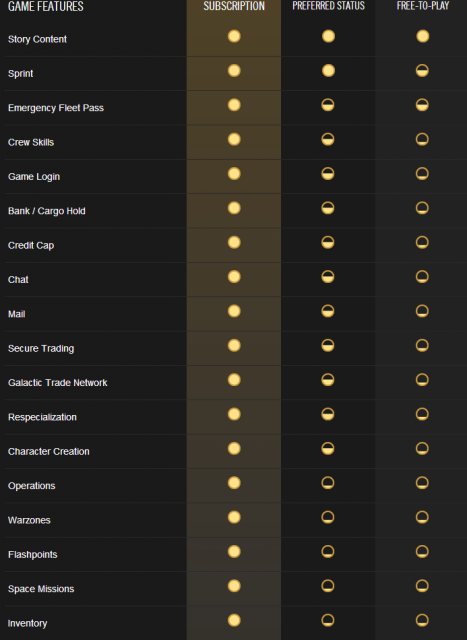
The problem is, Free-to-Play seems to go out of its way to force you to do the dumb, boring parts as much as possible. Free-to-Play restricts the experience gained, forcing you do to every goddamn sidequest, no matter how stupid, in order to remain barely on-level with your opponents in the primary class story. Moreover, it does…really, really stupid things for what seems to be no good reason, restricting all attempts to play this game with a friend or have any fun at all.
There’s the usual stuff, like in-game mounts, respecs, and quick travel, and so on, but there are also incredibly stupid ones.
Finish a quest? I’m sorry, quest rewards are only for subscribers. Want to sprint? Oh sure, that’s also for subscribers! Want an extra GUI toolbar? What are you, nuts? Guild? Not for you.
Want to send a letter to a friend ingame? Don’t worry, just spend $5 ingame for the privilege to Send. A. Fucking. Letter. Ingame.
And I thought cell phone companies charged me too much for text messages.
The shops even charge you extra just for being a free-to-play player, something that I’m sure would be annoying if I could muster the will to give a shit.
I mean, really, some of these just feel like someone drew up a laundry list of everything that could possibly be restricted from F2P players, and approved all of them without thinking.
Now, certainly, I agree that one has to find a way to monetize F2P players, but the goal is to get them invested in the game so that paying seems like a reasonable thing to do in exchange for enjoying yourself a bit more.
This is just a great way to convince anyone silly enough to try this game (like ourselves) that they were damned fools for doing so. Basically, stuff that you’d expect to be free (basic stuff like chat, guilds, etc) is paywalled or restricted, but beyond that, the game actively punishes you for choosing to play the story – the part Bioware lauded as their crowning innovation – forcing players to go through boring sidequests instead.
This isn’t to say that Free-to-Play is necessarily bad, its that the method with which TOR uses Free-to-Play seems like it’ll burn out customers really quickly. Whereas games like Lord of the Rings Online, Star Trek Online, TERA, and other free-to-play MMO’s seem to take the effort to get players invested in the game before they bring up the subject of paying for things, Star Wars: The Old Republic has no such patience for subtlety. You know from the first 30 minutes of playing that the developers want you to pay for the game, and they want you to do it now.
In 2013, the first year that SWTOR was Free-to-Play the whole year, the game did succeed in earning an impressive $165 million dollars, a good start on its way to earning back that debt of $400mil in initial expenses + ongoing development expenses.
However, upcoming signs aren’t good. EA’s quarterly reports indicate that SWTOR has been declining in revenue, and a rough guess would be that quarterly revenues have fallen about 20 million compared to previous quarters. If that’s the case, we’re going to see 2014 and 2015 revenues fall significantly, and it will be increasingly hard to convince higher level executives that the project is worth continued investment.
Why this failed
The prevailing narrative after TOR’s rather public and humiliating failure was that the majority of the budget was blown on completely unnecessary voice acting, and a prolonged, unsuccessful development time of 5 years.
Interestingly, James Ohlen was adamant that these were both myths in his talk at GDC 2013.
He claimed that voice was not a significant part of the budget, and that the development was not longer than the average, saying that the average development time for an MMO was 5 years
He instead noted a few issues that he was willing to put forward, and the list is strangely hilarious.
- Basic features such as chat, Guilds, and PvP were still under development in 2011
- In 2011, the game still could not support more than 10 players per zone
- The build cycle often went months at a time between working builds
- Features like the auction house’s search feature took 3 months worth of effort and some of their best programmers
- Choices and consequences took up the majority of their time and money
- Difficulty with a custom scripting system
- String tables weren’t working
Some of these seem almost impossibly horrible for a 300-man team with 5 years of effort, but they’re worth exploring. If we read into Ohlen’s assertion that choices and consequence took the most development time and effort, and take it at face value, there’s a strange contradiction.
As we mentioned last post, the choices and consequences of almost every choice feels…nonexistent. There is one thing, that might explain what Ohlen is saying, however. While the game itself allows no true impact to your choices, there is an immediate impact that is often ignored by the player.
The truth is, even if we didn’t care a solid 95% of the time, every choice leads to different things being spoken — which led to the popular myth that voice acting must have taken up all of the budget. But, there’s more to it. There’s lip syncing, characters moving, looking around, and in general engaging in actions that require truckloads of cinematographic effort, either with motion capture, or through keyframing each animation — and there’s at least 3, up to 9 different “cutscenes” for each quest, depending on the choice wheel selections. Either way, I suspect that this is what Ohlen was referring to when he was talking about the primary cost being choice.
On the flip side, the rest of what Ohlen says seems almost laughably self-contradictory. While its true that the average MMO takes 5 years in development, we usually expect to see…something better after 5 years. For a new MMO that comes out, we both expect to see the basics finished solidly, as well as a series of new, interesting takes on the MMO genre. The Bioware team believed precisely the opposite, deliberately choosing to not innovate, a choice so utterly hilarious it feels tempting to blame it on EA’s upper management.
That aside, Ohlen also describes a fairly tightly run ship for managing 300 developers, including movable desks, inter-disciplinary cooperation, having cross-disciplinary teams, and all sorts of other excellent management techniques that are, quite honestly, very impressively done.
This excellence in management clearly fell apart when it came to code, unfortunately. For those of you not aware of what builds are, a ‘build’ is a development version of the game, much in the manner of a version upgrade. Because development copies are moving so fast that using a 1.0 to 1.1 numbering system would be clunky and end with version 20.4, we often elect to use a more straightforward numbering system, but the general idea is that a build should be run weekly, if not daily, so that quality assurance and user experience can be tested on the latest version of the game.
To go months between working builds is the sign of an atrociously managed team, with people checking in broken code regularly instead of correctly handling them in branches. A general rule of thumb within Google’s team is that everyone takes responsibility for the code, and for the main branch to go days, let alone weeks broken is utterly unthinkable in a well run team.
To have it go broken for months implies absolutely atrocious management from whoever was in charge of the development repository. Furthermore, what kind of horrible roadmap target would have possibly allowed the team to not be done with features like Chat, guilds, PvP, or the ability to support more than 10 players per zone by 2011?!?!
Many have suggested that the infamous HeroEngine was to blame. To clarify, the Bioware team, lacking as they did in any MMO experience, elected to use a third party MMO “one-stop-solution” engine called HeroEngine in its beta format – an engine that has seen numerous criticisms for being slow, buggy, and inefficient. Whatever its proposed faults, one does wonder what HeroEngine even included if it didn’t support features such as chat, guilds, or massive amounts of players out of the box, that required the team at Bioware to build these features so late in the development cycle.
That said, I can’t help but feel like blaming the HeroEngine might be misplaced. While the engine certainly doesn’t appear to come out of the box with a lot of features, one can’t argue with the fact that at its peak, the core engine and technologies stood up to the initial wave of 1.5 million subscribers and kept going strong. The real issues didn’t end up being immense lag and networking issues, but the fact that the game simply wasn’t compelling enough. If the game had been compelling and fun, the HeroEngine could have, at the end of the day, taken the abuse and kept trucking.
That it wasn’t fun, was a fault that belongs to Bioware, and Bioware alone. As for the coding issues, its possible that the HeroEngine contributing to eyebrow-raising delays like taking 3 months to code a simple search feature, but it seems plainly obvious that there were other internal problems that probably mattered more.
What could make it better
In general, what could have improved the game could be divided into a few things: fixing the build pipeline (so proper testing could have been done), emphasizing meaningful choices and content, gameplay and story integration, and most of all, improved gameplay (even KOTOR would have been a step up).
First, the build pipeline. As mentioned, there were several months between testable builds – a problem that was not fixed until 3 months after release. As someone who has worked on a MMO – is absolutely atrocious.
Rahul: I actually worked on a small MMO back when I was younger (a small, fanmade one, only 50k users at its peak), and this part is the one that boggles my mind more than anything. In professional teams, such as the ones at major companies, most teams will not let the main branch(the part of development that is supposed to be used for testing) be broken for so much as a few hours — in the event that you accidentally break the main branch, you’re supposed to undo the changes within minutes, and then figure out what went wrong before trying again.
In our small, rather unprofessional team of open source developers, making a *fan* game, we would have main branch broken for days at a time, maybe as long as a week if we were having problems, but that was a small team of less than 4 programmers, and the only quality assurance was being done by ourselves.
For a team of 500 developers and an entire division of Quality Assurance and User Experience testers to have no builds for months several times seems downright, utterly insane to me. I may not be best programmer in the world, but I can safely say that of all the insane management problems I’ve heard of in the past, I have never heard of one this bad.
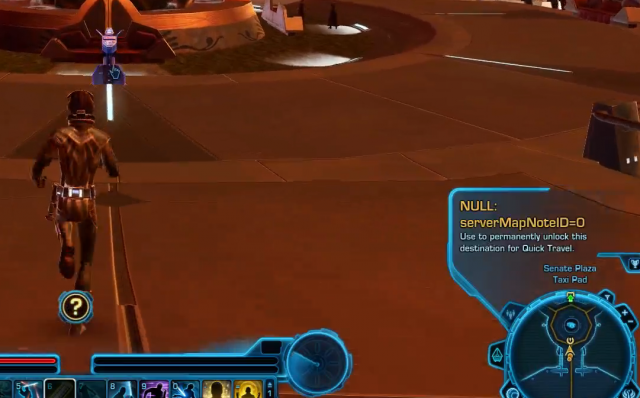
Because, when you don’t test it, there are bugs on things as simple as string tables, and let me just say that it looks really unprofessional to have the screen say *&^% #$@ 13374@x unlocked” when one interacts with an item.
The next major thing that could have improved the game is emphasizing meaningful choices and content, given that meaningful choice was what Bioware stated over and over to be the crowning achievement of SWTOR, the innovation that set it apart from all other MMOs. Unfortunately, very little content in the game actually felt meaningful, and the player was usually pulled away from what little there was by sidequests – all with their own cutscenes. This diluted the story arcs by destroying the sense of urgency and power that the main quest had managed to build up. And of course, then we have the vaunted light/dark side choices and the consequences of these choices.
Or should I say, the lack of consequences? In the Star Wars Universe, choosing the light or the dark is supposed to have huge effects, with a character who has started down the dark side finding it easier and easier to make dark choices and vice versa (just like in KOTOR). But this is not the case in TOR, where the options remain the same regardless of what you do and your only differences are cosmetic changes. If they had changed conversation options, reputation, abilities and combat style, something, that would have been an interesting mechanic.
But they didn’t – which boggles the mind because they had already done it back in KOTOR.
Which leads us to our next point: DO NOT SEGREGATE STORY FROM GAMEPLAY!!! Completely aside from the light/dark side choices, the story sucked in that there was no tension, no urgency, no meaningful integration with world and character design. Using the Jedi Knight story as an example, we’re told that there is this great threat to the Order in the very heart of its power – and its easily pushed aside by a level 7 character – not even an apprentice – which makes one wonder what the hell the Masters are doing. Your character being seen as powerful should not make the other NPCs incompetent – you should feel as if you have done something amazing, as opposed to you being the only half-competent Jedi on the blasted rock. I could have understood if the Jedi Knight were already going through Knighthood Trials on some other planet, and were asked to confront a Sith Threat without support – that would have made sense – not having to face down a “threat to the Order” when there are Knights and Masters that could have done it for you, since they are max level NPCs and you are not.
Instead, your Master, a max-level NPC, is defeated with ease by a Padawan – without the bonus of some ancient relic or device that would have given him an advantage – that you then proceed to take down in a few hits. This does not make sense. Neither is the Flesh Raider “raid” any sort of threatening, when the three Jedi perimeter guards slaughter them with ease. TL;DR, because of the world design, the Jedi Knight story doesn’t make any sense.
Which brings us to the single area most direly in need of improvement — the gameplay. The problem in TOR is that the combat…is…dull.
The combat follows the stock-standard formula of MMO’s, and doesn’t really bother to either improve on it, or even take the effort to be interesting. There’s not even a rotation of different attacks that buff you up, or any skill that creates temporary HP, or…anything. The game just follows the formulaic approach of having some skills that increase your MP, and some that cost MP. Its not particularly interesting, though with Republic Trooper the nice thing is you start at full MP, whereas in Jedi Knight you start every battle with none. In short, they managed to clone the “standard” MMO combat system and make it more dull than any other version of it I’ve ever played.
The hilarious part is the game could have been improved by simply including KOTOR’s combat mechanics, which were based off the d20 system used in D&D and other tabletop RPG’s. I’m not even going to dare to ask for a decent MMO combat system like the one introduced in TERA, which manages to blend the traditional MMO combat system with a more action-oriented one.
In sum, what would have made SWTOR better would be if Bioware had just made KOTOR III. Failing that, properly adjusting the story and gameplay for a MMO where people play together would have been nice. Furthermore, KOTOR III likely would not have had as obscenely large a budget, and might have (gasp!) been a reasonably profitable game, ensuring future games in the franchise. As it is, the franchise’s continuation is highly in doubt, and even if it were to be picked up, there’s now a massive 8-storyline mess that has to be tied up and dealt with by any game set in this universe – unless the game were to be declared non-canon, of course, which we would also be fine with, given that it so utterly butchered the KOTOR arcs as it is.
